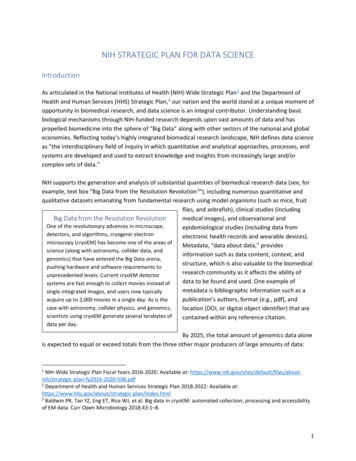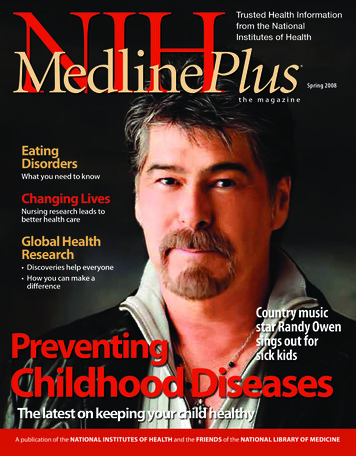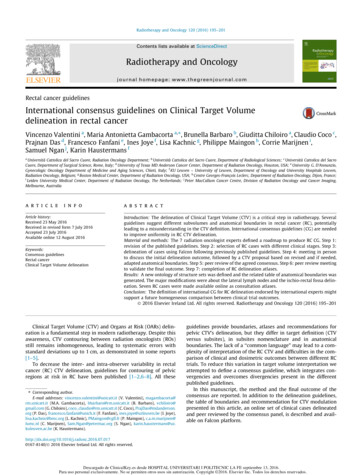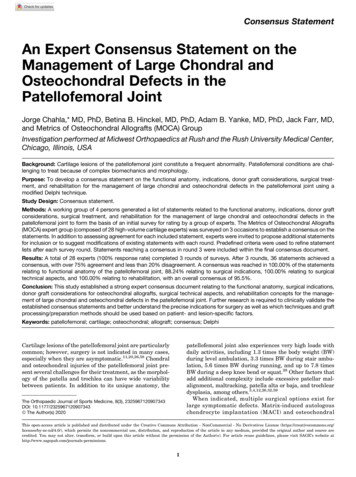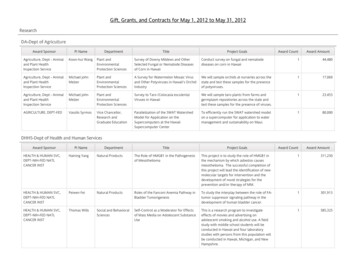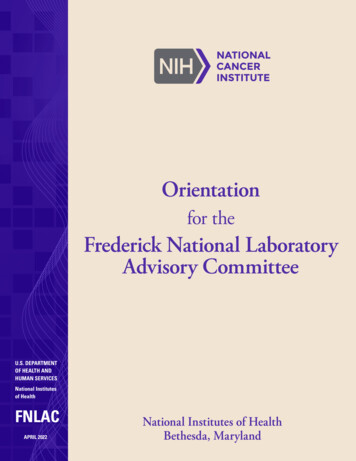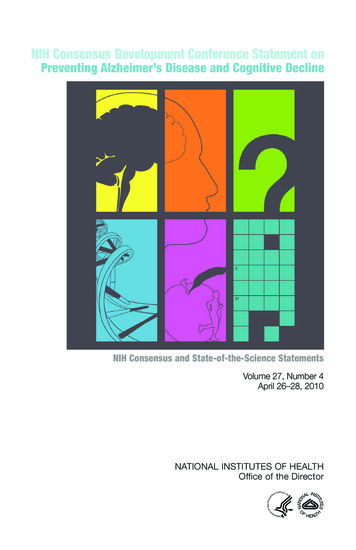
Transcription
NIH Consensus Development Conference Statement onPreventing Alzheimer’s Disease and Cognitive DeclineNIH Consensus and State-of-the-Science StatementsVolume 27, Number 4April 26–28, 2010NATIONAL INSTITUTES OF HEALTHOffice of the Director
About the NIH Consensus Development ProgramNational Institutes of Health (NIH) Consensus and State-of-theScience Statements are prepared by independent panels of healthprofessionals and public representatives on the basis of (1) the resultsof a systematic literature review prepared under contract with theAgency for Healthcare Research and Quality (AHRQ), (2) presentationsby investigators working in areas relevant to the conference questionsduring a 2-day public session, (3) questions and statements fromconference attendees during open discussion periods that are part ofthe public session, and (4) closed deliberations by the panel duringthe remainder of the second day and the morning of the third. Thisstatement is an independent report of the panel and is not a policystatement of the NIH or the Federal Government.The statement reflects the panel’s assessment of medical knowledgeavailable at the time the statement was written. Thus, it provides a“snapshot in time” of the state of knowledge on the conference topic.When reading the statement, keep in mind that new knowledge isinevitably accumulating through medical research, and that the informationprovided is not a substitute for professional medical care or advice.Reference InformationIndividuals who wish to cite this statement should use thefollowing format:Daviglus ML, Bell CC, Berrettini W, Bowen PE, Connolly ES, Cox NJ,Dunbar-Jacob JM, Granieri EC, Hunt G, McGarry K, Patel D, PotoskyAL, Sanders-Bush E, Silberberg D, Trevisan M. National Institutesof Health State-of-the-Science Conference Statement: PreventingAlzheimer’s Disease and Cognitive Decline. NIH Consens State SciStatements. 2010 Apr 26–28;27(4):1–30.Publications Ordering InformationNIH Consensus Statements, State-of-the-Science Statements, andrelated materials are available by visiting http://consensus.nih.gov; bycalling toll free 888–644–2667; or by emailing consensus@mail.nih.gov.Written requests can be mailed to the NIH Consensus DevelopmentProgram Information Center, P.O. Box 2577, Kensington, MD 20891.When ordering copies of this statement, please reference item number2010-00034-STMT.The evidence report prepared for this conference through AHRQ isavailable on the web via http://www.ahrq.gov/clinic/tp/alzcogtp.htm.Printed copies may be ordered from the AHRQ PublicationsClearinghouse by calling 800–358–9295. Requesters should ask forAHRQ Publication No. 10-E005.
NIH Consensus Development Conference Statement onPreventing Alzheimer’s Disease and Cognitive DeclineNIH Consensus and State-of-the-Science StatementsVolume 27, Number 4April 26–28, 2010NATIONAL INSTITUTES OF HEALTHOffice of the Directori
Disclosure StatementAll of the panelists who participated in this conferenceand contributed to the writing of this statement wereidentified as having no financial or scientific conflict ofinterest, and all signed forms attesting to this fact. Unlikethe expert speakers who present scientific data at theconference, the individuals invited to participate on NIHConsensus and State-of-the-Science Panels are reviewedprior to selection to ensure that they are not proponentsof an advocacy position with regard to the topic and arenot identified with research that could be used to answerthe conference questions.For more information about conference procedures,please see http://consensus.nih.gov/aboutcdp.htm.Archived Conference WebcastThe NIH State-of-the-Science Conference: PreventingAlzheimer’s Disease and Cognitive Decline waswebcast live April 26–28, 2010. The webcast isarchived and available for viewing free of chargeat http://consensus.nih.gov/2010/alz.htm.ii
AbstractObjectiveTo provide healthcare providers, patients, and thegeneral public with a responsible assessment of currentlyavailable data on the prevention of Alzheimer’s diseaseand cognitive decline.ParticipantsA non-Department of Health and Human Services,nonadvocate 15-member panel representing the fieldsof preventive medicine, geriatrics, internal medicine,neurology, neurological surgery, psychiatry, mentalhealth, human nutrition, pharmacology, genetic medicine,nursing, health economics, health services research,family caregiving, and a public representative. In addition,20 experts from pertinent fields presented data to thepanel and conference audience.EvidencePresentations by experts and a systematic review ofthe literature prepared by the Duke University Evidencebased Practice Center, through the Agency for HealthcareResearch and Quality (AHRQ). Scientific evidence wasgiven precedence over anecdotal experience.Conference ProcessThe panel drafted its statement based on scientificevidence presented in open forum and on publishedscientific literature. The draft statement was presentedon the final day of the conference and circulated to theaudience for comment. The panel released a revisedstatement later that day at http://consensus.nih.gov. Thisstatement is an independent report of the panel and is nota policy statement of the NIH or the Federal Government.1
ConclusionsCognitive decline and Alzheimer’s disease are majorcauses of morbidity and mortality worldwide and aresubstantially burdensome to the affected persons, theircaregivers, and society in general. Extensive researchover the past 20 years has provided important insights onthe nature of Alzheimer’s disease and cognitive declineand the magnitude of the problem. Nevertheless, thereremain important and formidable challenges in conductingresearch on these diseases, particularly in the area ofprevention. Currently, firm conclusions cannot be drawnabout the association of any modifiable risk factor withcognitive decline or Alzheimer’s disease. Highly reliableconsensus-based diagnostic criteria for cognitive decline,mild cognitive impairment, and Alzheimer’s disease arelacking, and available criteria have not been uniformlyapplied. Evidence is insufficient to support the use ofpharmaceutical agents or dietary supplements to preventcognitive decline or Alzheimer’s disease. We recognizethat a large amount of promising research is under way;these efforts need to be increased and added to bynew understandings and innovations (as noted in ourrecommendations for future research).For example, ongoing studies including (but not limitedto) studies on antihypertensive medications, omega-3fatty acids, physical activity, and cognitive engagementmay provide new insights into the prevention or delay ofcognitive decline or Alzheimer’s disease. This importantresearch needs to be supplemented by further studies.Large-scale population-based studies and randomizedcontrolled trials (RCTs) are critically needed to investigatestrategies to maintain cognitive function in individualsat risk for decline, to identify factors that may delay theonset of Alzheimer’s disease among persons at risk,and to identify factors that may slow the progressionof Alzheimer’s disease among persons in whom thecondition is already diagnosed.2
IntroductionAlzheimer’s disease is the most common cause ofdementia. It was first described in 1906 by Germanpsychiatrist and neuropathologist Alois Alzheimer, whoobserved the pathological hallmarks of the disease—abnormal clumps of protein (beta-amyloid plaques) andtangled bundles of protein fibers (neurofibrillary tangles)—in the brain of a female patient who had experiencedmemory loss, language problems, and unpredictablebehavior. An important breakthrough was the inventionof the photomicrograph in the early 1900s by SolomonCarter Fuller, an African American psychiatrist; this keyinnovation provided a method for taking photographsthrough the lens of a microscope, allowing visualizationof amyloid plaques and neurofibrillary tangles.Since its first description, Alzheimer’s disease hasgone from a rarely reported disorder to one of themost common disabling diseases among older adults.The increasing proportion of older adults in the U.S.population reinforces the urgent need for prevention andtreatment of all chronic diseases including Alzheimer’sdisease. In most individuals, cognitive health andperformance remain stable over the lifetime, with only agradual decline in short-term memory and processingspeed. For others, however, the decline in cognitivefunction progresses to a more serious state of cognitiveimpairment or into various forms of dementia. Mildcognitive impairment is characterized by problems withmemory, language, or other essential cognitive functionsthat are severe enough to be noticed by others and arereflected on cognitive tests, but are not severe enoughto interfere with daily life. Dementia is characterized byprogressive global deterioration of cognitive abilitiesin multiple domains including memory and at leastone additional area—learning, orientation, language,comprehension, and judgment—severe enough tointerfere with daily life.3
The diagnosis of Alzheimer’s disease is difficult andoften imprecise, but its importance is without question.Depending on the diagnostic and pathologic criteriaemployed, Alzheimer’s disease accounts for 60 to80 percent of all dementia cases. As many as 5.1million Americans may currently have the disease, andthe prevalence of mild cognitive impairment is evenhigher. Furthermore, the number of persons affectedby Alzheimer’s disease or mild cognitive impairment isexpected to increase considerably with the aging of thebaby boomer generation. Alzheimer’s disease is the sixthleading cause of death in the United States and the fifthleading cause of death in Americans age 65 and older.Alzheimer’s disease and other dementias cost more than 148 billion in the United States annually, and theseconditions also exact a substantial toll on patients andcaregivers in terms of financial costs, stress, and anguish.To date, numerous studies have attempted to describethe etiology and factors associated with the riskfor development and progression of mild cognitiveimpairment and Alzheimer’s disease, generating anabundance of theories on potential risk factors andtherapies. Age is the strongest known risk factor forAlzheimer’s disease; most people with the late-onsetform of the disease receive the diagnosis after age 60.An early-onset familial form also occurs, but it is rare.Genetic, cardiovascular, and lifestyle factors also havebeen implicated.To examine this important topic more closely, the NationalInstitute on Aging and the Office of Medical Applicationsof Research of the National Institutes of Health conveneda State-of-the-Science Conference on April 26–28, 2010,to assess the available scientific evidence related to thefollowing questions:1. What factors are associated with the reduction of riskof Alzheimer’s disease?4
2. What factors are associated with the reduction of riskof cognitive decline in older adults?3. What are the therapeutic and adverse effects ofinterventions to delay the onset of Alzheimer’sdisease? Are there differences in outcomes amongidentifiable subgroups?4. What are the therapeutic and adverse effects ofinterventions to improve or maintain cognitive abilityor function? Are there differences in outcomes amongidentifiable subgroups?5. What are the relationships between the factors thataffect Alzheimer’s disease and the factors that affectcognitive decline?6. If recommendations for interventions cannot be madecurrently, what studies need to be done to provide thequality and strength of evidence necessary to makesuch recommendations to individuals?At the conference, invited experts presented informationrelevant to these questions. A systematic evidence review,prepared under contract with the Agency for HealthcareResearch and Quality (AHRQ) from the Evidence-basedPractice Center (EPC) at Duke University’s ClinicalResearch Institute, was summarized (available athttp://ahrq.gov/clinic/tp/alzcogtp.htm). It emphasizedrandomized controlled trials (RCTs) with health outcomesas their endpoints. Conference participants also providedoral and written comments in response to the conferencequestions, and the panel considered all of this evidencewhen preparing the consensus statement.The panel review included relevant studies on therelationship of multiple factors, including nutritional,medical, social, economic, behavioral, environmental, andgenetic, with mild cognitive impairment or Alzheimer’sdisease. The scope of the review was restricted tohuman studies conducted in developed countries with5
sample sizes of at least 50 participants for RCTs and 300participants for observational studies, and a minimumduration between exposure to preventive interventionsand outcomes—to assess success of interventions—of 1year for studies of mild cognitive impairment and 2 yearsfor studies of Alzheimer’s disease. The panel consideredstudies published in English that included participants50 years or older, of both sexes, and of diverse racialand ethnic populations. Studies were rated by the EPCbased on their quality by using the GRADE (Gradingof Recommendations Assessment, Development, andEvaluation) criteria. The panel’s charge was confined toanswer questions related to prevention and not treatmentof established Alzheimer’s disease and cognitive decline.1. What Factors Are Associated With theReduction of Risk of Alzheimer’s Disease?Currently, no evidence of even moderate scientific qualityexists to support the association of any modifiable factor(such as nutritional supplements, herbal preparations,dietary factors, prescription or nonprescription drugs,social or economic factors, medical conditions, toxins,or environmental exposures) with reduced risk ofAlzheimer’s disease.What We KnowGenetic factors, particularly the apolipoprotein E (ApoE)gene variation, are associated with risk of Alzheimer’sdisease. Although better understanding of genetic riskfactors for Alzheimer’s disease may ultimately lead toeffective therapies, the observed genetic associationsare currently relevant largely as stratification factors instudies designed to identify additional risk factors and inclinical trials designed to test effectiveness of therapies.6
Numerous modifiable factors have been reported to showassociation with risk for Alzheimer’s disease across multiplestudies, but the overall scientific quality of the evidence islow. Thus additional studies on these factors may change,perhaps substantially, the magnitude or direction of theobserved associations. Chronic diseases and conditionssuch as diabetes, elevated blood cholesterol level in midlife,and depression have been associated with increased riskof Alzheimer’s disease. Several dietary and lifestyle factorsand medications also have been linked to a decreasedrisk of Alzheimer’s disease; these include adequate folicacid intake, low saturated fat consumption, high fruit andvegetable consumption, use of statins, light to moderatealcohol consumption, educational attainment, cognitiveengagement, and participation in physical activities. Currentsmoking, never having been married, and having low socialsupport are all reported to be associated with increasedrisk of Alzheimer’s disease. However, the quality of evidencefor the association of these factors with Alzheimer’sdisease is low. No consistent associations were found forother vitamins; fatty acids; the metabolic syndrome; bloodpressure; plasma homocysteine level; obesity and bodymass index; antihypertensive medications; nonsteroidalanti-inflammatory drugs; gonadal steroids; or exposuresto solvents, electromagnetic fields, lead, or aluminum.LimitationsOne of the challenges of interpreting findings of existingstudies on risk factors for Alzheimer’s disease is the lack ofa consistent and uniformly applied definition of Alzheimer’sdisease. Another key challenge is distinguishing factorsassociated with Alzheimer’s disease from factors associatedwith other late-onset disorders that are prevalent in olderadults. For example, vascular disease can lead todementias, and because vascular disease is commonin elderly persons, it often may be present in individualswith Alzheimer’s disease. Thus, it can be difficult todifferentiate between factors associated with Alzheimer’s7
disease because of their contribution to vascular diseaseand related dementias and factors that are truly associatedwith Alzheimer’s disease. Similarly, it is unclear whethersome of the observed associations, such as depression,might reflect early features of Alzheimer’s disease.The primary limitation of most of these studies is thedistinction between association and causality. Diseasesare complex; they are determined and shaped by manyvariables. Factors that are reproducibly associated withdisease, even when they are not contributing causally,can still be useful as potential predictors of risk. But theprimary reason that association studies are conductedis to identify factors that might actually contribute torisk of disease. A key problem with associations is thatthey often involve factors that are themselves correlated.For example, individuals with higher levels of educationalso are more likely to have higher levels of cognitiveengagement. When a set of correlated factors showsan association with disease, it is difficult to determinewhether any (or all) of the factors contributes causally todisease. Alternatively, one or more unobserved factors(correlated with the others) may actually account for theobserved associations.2. What Factors Are Associated With theReduction of Risk of Cognitive Declinein Older Adults?Cognition is a combination of skills that include attention,learning, memory, language, visuospatial skills, andexecutive function, such as decisionmaking, goal setting,planning, and judgment. Decline in cognition ranges fromsevere dementia, such as Alzheimer’s disease, to mildcognitive impairment and age-related cognitive decline.Cognitive decline is multicausal, and mild cognitiveimpairment does not always progress to dementia.Neuropsychological testing for the above-mentioned8
skills over varying time periods has been the predominantmethod for the evaluation of cognitive change, butfunctional cognitive decline is only moderately associatedwith pathologic changes typical of Alzheimer’s disease.The idea of cognitive reserve (the mind’s resilience toneuropathologic damage of the brain) explains variancesin ability to cope physiologically and mentally with existingpathology. Despite the hopeful insights provided by thisconcept, these issues complicate attempts to designrobust studies to determine factors that might preventcognitive decline.What We KnowFor most factors, existing studies either show noassociation with cognitive decline or provide inconclusiveevidence. Where an association was seen, the overallquality of the evidence is low.Nutritional and Dietary Factors. The available evidencedoes not support a clear role for most of the nutritionaland dietary factors that have been examined. The mostconsistent evidence is available for longer chain omega-3fatty acids (often measured as fish consumption), withseveral longitudinal studies showing an association withreduced risk for cognitive decline. For the other factors,the evidence varies from no consistent association(vitamin B, vitamin E, vitamin C, folate, and beta-carotene)to very limited evidence suggesting a possible protectiveeffect (low saturated fat and high vegetable intake).Medical Factors. Several cardiovascular risk factorshave been consistently associated with increased riskfor cognitive decline. High blood pressure has beenmost consistently associated with cognitive decline,and particularly with severe cognitive decline. Diabetesalso has been associated with an increased risk forcognitive decline, but this association is modest andless consistent. The metabolic syndrome, a cluster ofmetabolic abnormalities, has been consistently associated9
with a modest risk for cognitive decline. For other medicalfactors, good-quality studies are lacking (for example,sleep apnea and traumatic brain injury) or findings havebeen inconclusive (for example, obesity).Psychological and Emotional Health. Depression anddepressive symptoms have been consistently foundto be associated with mild cognitive impairment andcognitive decline.Medications. No consistent epidemiologic evidenceexists for an association with statins, antihypertensivemedications, or anti-inflammatory drugs. Data areinsufficient to comment on cholinesterase inhibitorsor memantine. Existing reports are difficult to interpretbecause of variation in formulations, dosage, duration,route of administration (as for postmenopausalestrogens), and drug treatment effect (for example,antihypertensive medications).Socioeconomic Factors. Childhood socioeconomic statusor cognitive milieu does not appear to strongly influencecognitive decline later in life. Evidence on the putativeassociation between years of education and cognitivedecline is inconsistent.Social and Cognitive Engagement. Whereas findingson the association of cognitive decline with living aloneor being without a partner are inconsistent, a robustassociation exists between the loss of a spouse andcognitive decline. Limited but inconsistent evidencesuggests that increased involvement in cognitive activitiesin later life may be associated with slower cognitivedecline and lower risk for mild cognitive impairment.Physical Activity and Other Leisure Activities. Preliminaryevidence suggests beneficial associations of physicalactivity and other leisure activities (such as clubmembership, religious services, painting, or gardening)with preservation of cognitive function.10
Tobacco and Alcohol Use. Evidence indicates that currentsmoking is associated with increased risk for cognitivedecline; evidence for past smoking is less consistent.Findings on the association between cognitive declineand alcohol use are inconsistent.Genetic Factors. Most studies suggest that the ApoEgene variation is associated with an increased rate ofcognitive decline in elderly persons, especially on somememory tasks and tasks of perceptual speed. The ApoEgene variation does not seem to affect all cognitivedomains, and there is variability among studies.LimitationsMuch of the available evidence derives from studies thatwere originally designed and conducted to investigate otherconditions, such as cardiovascular disease and cancer.Thus, evidence from studies conducted to date is limitedby methodological issues in the assessment of the outcome(cognitive decline) or exposures (risk factors). Limitationsin the evaluation of outcome include the lack of a cleardefinition of and standardization of criteria for cognitivedecline (cognitive decline is not a single entity and may havedifferent etiologies). Instruments used by different studiesvaried in their scope, making it difficult or impossible tocompare results across studies and to identify the reasonsfor inconsistency in findings. The ascertainment ofcognitive decline was often limited to a single measurementat follow-up. This approach severely limits the ability todetermine validly whether cognitive decline really exists,especially because cognitive decline is not linear, manyfactors affect cognitive performance, and these factors maychange in the same individual. Many studies were limitedby the relatively short duration of follow-up. The studiesalso differ widely in the quality of the measurements ofimportant exposures (for example, dietary factors, lifestylehabits, medications, health history, social factors, andengagement). Many of the available studies characterizedtheir participants only at a single time point.11
3. What Are the Therapeutic and AdverseEffects of Interventions to Delay theOnset of Alzheimer’s Disease? AreThere Differences in Outcomes AmongIdentifiable Subgroups?Although numerous interventions have been suggestedto delay Alzheimer’s disease, the evidence is inadequateto conclude that any are effective. Our conclusions arebased on a review of published literature of adequatelypowered randomized controlled trials (RCTs), the mostrigorous, highest quality evidence. RCTs are studiesin which participants are allocated by chance alone toreceive one or more treatment interventions. Becauseof the protracted course of Alzheimer’s disease, ourconclusions are based on RCTs that were at least 2 yearsin duration and adequately powered. Our conclusionsdo not reflect the existence of observational studies inwhich the investigator does not assign the exposure ortreatment of interest to participants. However, informationfrom these observational studies has formed, and willform, the basis for RCTs.Assessment of Detailed InterventionsVitamins, Nutrients, and Dietary Supplements. Arecent RCT of vitamin E found no evidence that thisfactor changed the onset of Alzheimer’s disease.Other nutritional factors (such as other vitamins or theMediterranean diet) may be beneficial, but evidenceto support this conclusion is insufficient. It has beensuggested that patients with vitamin deficiency maydemonstrate a greater response, but no trials haveexamined this issue. Gingko biloba was reported tohave some benefit in small, short-term clinical trials.12
However, a recent, large long-term RCT comparinggingko biloba with placebo showed no reduction inthe incidence of Alzheimer’s disease, leading to theconclusion that evidence is insufficient to support theefficacy of gingko biloba.Medications. Cholinesterase inhibitors are the mostcommon treatment for mild to moderate Alzheimer’sdisease and have been the focus of several RCTsevaluating prevention of Alzheimer’s disease. Althoughthere is some inconsistency in the literature, the bodyof evidence led us to conclude that this class of drugsdoes not effectively prevent Alzheimer’s disease.Evidence from RCTs of antihypertensive medicationsand hormone replacement (conjugated equine estrogen)is also insufficient to indicate that these agents protectagainst Alzheimer’s disease. Some available evidenceshows that certain medications may increase theincidence of Alzheimer’s disease. Two RCTs of specificnonsteroidal anti-inflammatory drugs—rofecoxib,naproxen, and celecoxib—suggested an increasedincidence of Alzheimer’s disease with treatment.However, these studies were limited by high dropoutrates and early termination because of concerns abouttoxicity. Two RCTs of conjugated equine estrogen,one combined with methylprogesterone, suggested anincreased incidence of dementia (including Alzheimer’sdisease) with treatment. These trials suggest that noknown medication can be said to reliably delay theonset of Alzheimer’s disease.Other Factors. No RCTs were identified that evaluatedthe effects of cognitive engagement, physical activities,or other leisure activities for delaying the onset ofAlzheimer’s disease.13
4. What Are the Therapeutic and AdverseEffects of Interventions to Improve orMaintain Cognitive Ability or Function?Are There Different Outcomes inIdentifiable Subgroups?Several interventions have been evaluated with respectto improving cognitive function or preventing cognitivedecline. Despite some encouraging associations found inobservational studies, RCTs of specific interventions havenot definitively established positive therapeutic effects onmaintaining or improving cognitive function, or preventingcognitive decline. However, there also is little evidence tosuggest that interventions designed to improve cognitivefunction either worsen it or produce unwanted sideeffects. In addition, no data are available from which todraw firm conclusions about differences in outcomesamong identifiable subgroups. Some of the main reasonsfor the inability to identify successful interventions mayinclude (1) lack of a validated and consistent definitionof cognitive decline; (2) the small number of RCTs withcognitive decline as a primary outcome; (3) limitationsof study design and analysis including short follow-upduration, biases and inconsistencies in study subjectrecruitment, small effect sizes, and confounding effectsof multiple interrelated behaviors.Assessment of Detailed InterventionsVitamins, Nutrients, and Dietary Supplements. SeveralRCTs did not find a role of vitamin supplementationin preventing cognitive decline. However, these trialsused varying doses of the nutrients, did not uniformlymeasure and monitor patients’ cognitive function andbaseline nutritional status, had short and variablefollow-up, and mostly measured cognitive decline asa secondary or tertiary outcome. Thus these trialsmay have been underpowered.14
In a randomized trial complicated by poor adherence totherapy, gingko biloba co-administered with vitamin Edid not improve or maintain cognitive function in elderlypersons. A randomized trial of omega-3 fatty acids withonly 26 weeks of follow-up found no effect on cognitivefunctioning. Other trials in progress may revise thisevidence, but currently no interventional trials convincinglydemonstrate that dietary supplements improve ormaintain cognitive functioning.Medications. With the exception of a single trial ofantihypertensive medication in patients with hypertension,known vascular disease, and history of stroke, all existingevidence suggests that antihypertensive treatment resultsin no cognitive benefit. Similarly, treatment with statins,low-dose aspirin, or celecoxib did not result in cognitivebenefit, and naproxen was found to possibly increasecognitive decline. Randomized trials of estrogen have notshown any preventive effects on cognitive decline, andconjugated equine estrogen plus methylprogesteronemay worsen cognitive outcome. However, trials examiningthe effect of gonadal steroids to date have had severalshortcomings, including inconsistencies in types of steroidused, duration and timing of use, type of menop
The diagnosis of Alzheimer's disease is dificult and often imprecise, but its importance is without question. Depending on the diagnostic and pathologic criteria employed, Alzheimer's disease accounts for 60 to 80 percent of all dementia cases. As many as 5.1 million Americans may currently have the disease, and

